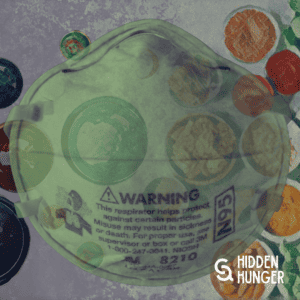 I remember in the early days of the pandemic, when it felt like the Hunger Games just going grocery shopping and supply chain delays caused shortages and long wait times for some grocery stores items. Panic set in, making the shortages worse as people stockpiled toilet paper, water, and pantry items—that is, those who could afford to do so.
I remember in the early days of the pandemic, when it felt like the Hunger Games just going grocery shopping and supply chain delays caused shortages and long wait times for some grocery stores items. Panic set in, making the shortages worse as people stockpiled toilet paper, water, and pantry items—that is, those who could afford to do so.
Food insecurity, depending on which measurement you read, peaked at somewhere between 14-20% of U.S. households during the pandemic. The U.S. Department of Agriculture defines food insecurity, or hunger, as “a household-level economic and social condition of limited or uncertain access to adequate food.” This can look like not being able to afford a balanced meal or skipping meals. Food insecurity causes poor health in children and adults and is linked to children having trouble paying attention and doing well in school. Healthy People 2030, a set of 10-year health objectives for the U.S., set a goal to reduce food insecurity to 6% by the year 2030. In 2018, the prevalence was 11% for the total population, and the most recent data posted says in 2021 the prevalence was 10%. We may initially assume the story is not that bad, but let’s take a closer look.
A study in the first year of the pandemic found that about 30% of the U.S. population experienced some kind of risk for hunger, but not everyone experienced the initial shocks of supply-chain disruptions in the same way. Generally, people who were older, had a higher income, and identified as white did not experience hunger. People of color, younger people, those with lower income, females, and people with children in the household are those who became or remained food insecure.
Depressingly, our efforts to address hunger in the U.S. over recent decades have not made much of an impact. The nationwide measurement of food insecurity began in 1995. The prevalence then was almost the same as what it is now. How is that possible? Indeed, food policy experts have acknowledged that “the existence of widespread food insecurity in a country with the world’s largest economy—one that produces a cornucopia of food even to the point of grand-scale exports of surplus commodities—is morally reprehensible.” Historically, we have seen income, education level, and employment be key determinants of food access. Public policy efforts like providing nutrition assistance, increasing benefit amounts, and addressing unemployment have helped, but these programs are continually on the budget chopping block.
Another persistent trend is the food security gap between BIPOC communities and whites. From 2019 to 2022, Hispanic/Latinx and Black adults were consistently at greater risk of food insecurity than white adults. Racism is a fundamental driver of food insecurity, due to how race is intertwined with education, income, and employment. Familial wealth passed on to generations of inheritance is lower among Black families than white families. Structural racism has been given more attention of late, as embedded discrimination in policies and practices that govern not only food policy but also healthcare and housing impacts our social safety net.
The Old Testament prophets had something to say about how to treat people experiencing hunger. The prophet Amos said,
Hear this word, you cows …, you women who oppress the poor and crush the needy and say to your husbands, “Bring us some drinks!” The Sovereign Lord has sworn by his holiness: “The time will surely come when you will be taken away with hooks, the last of you with fishhooks.” (4:1-2)
Amos goes on to say that their disregard for the hungry will have a poor result. The Lord tried to get their attention—in many ways. A plague of locusts destroyed their land. There was drought. The land was devastated and people went hungry.
Does this sound strangely familiar? The locust plague reminds me of how the COVID-19 pandemic laid bare all of the social disparities that we have been living with—disparities that many conveniently ignore. People who struggled normally to survive were suffering under added layers of stress and economic side effects. Will we pay attention this time?
As we gear up for summer, let’s do more than making sure the grill fires up, patio furniture is washed, and there is enough sunscreen in the beach bags. Summer is when donations to food pantries and others serving families experiencing hunger need donations the most. Food insecurity does not go away while you are on vacation. So consider picking up an extra bag of groceries for your local food pantry before you travel, or if you garden, drop off your extras, and stay up to date with local and nationwide efforts to address food insecurity.
 Sarah String is a Sider Scholar and M.Div. student at Palmer Theological Seminary. Her passion is to see holistic public health be evidence of God’s Kingdom. Sarah works in public health program evaluation.
Sarah String is a Sider Scholar and M.Div. student at Palmer Theological Seminary. Her passion is to see holistic public health be evidence of God’s Kingdom. Sarah works in public health program evaluation.


